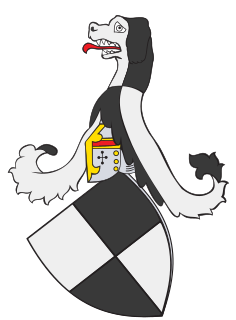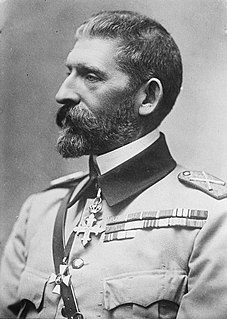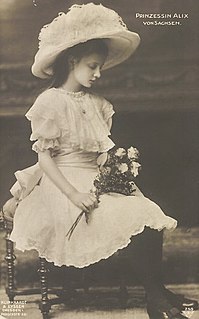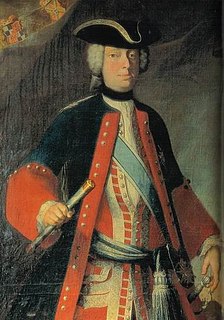
The House of Hohenzollern[ˈhoːəntsɔlɐn] is a German dynasty of former princes, electors, kings and emperors of Hohenzollern, Brandenburg, Prussia, the German Empire, and Romania. The family arose in the area around the town of Hechingen in Swabia during the 11th century and took their name from Hohenzollern Castle. The first ancestors of the Hohenzollerns were mentioned in 1061.

Hohenzollern-Sigmaringen was a principality in southwestern Germany. Its rulers belonged to the senior Swabian branch of the House of Hohenzollern. The Swabian Hohenzollerns were elevated to princes in 1623. The small sovereign state with the capital city of Sigmaringen was annexed to the Kingdom of Prussia in 1850 following the abdication of its sovereign in the wake of the revolutions of 1848, then became part of the newly created Province of Hohenzollern.

Ferdinand I, nicknamed Întregitorul, was King of Romania from 1914 until 1927. Although a member of Germany's ruling Hohenzollern imperial family, Ferdinand sided against the Central Powers in World War I. Thus, at the war’s end, Romania emerged as a much-enlarged kingdom, including Bessarabia, Bukovina and Transylvania, and Ferdinand was crowned king of ‘Greater Romania’ in a grand ceremony in 1922. He died from cancer in 1927, succeeded by his grandson Crown Prince Michael under a regency.
Prince Carl Christian of Hohenzollern is the eldest child of Prince Johann Georg of Hohenzollern and of his wife Princess Birgitta of Sweden, sister of King Carl XVI Gustaf of Sweden.

Prince Karl Anton of Hohenzollern-Sigmaringen was head of the Princely House of Hohenzollern-Sigmaringen, Hohenzollern from 1869 and Prime Minister of Prussia. He was the son of Karl, Prince of Hohenzollern-Sigmaringen, who abdicated in favour of his son on 27 August 1848, and his first wife Marie Antoinette Murat, niece of Joachim Murat.

The succession order to the throne of the Romanian monarchy, abolished since 1947, was regulated by the monarchical constitution of 1938, suspended by the Royal Law Decree no. 3052 of September 1940 and the 1884 Law of the Romanian Royal House Rules enacted pursuant to the 1866 Constitution of Romania which had confirmed the enthronement of Prince Karl (Carol) of Hohenzollern-Sigmaringen. The 1938 Constitution stipulated Salic law, according to which the throne was hereditary in King Carol I's legitimate descent and, if his male issue failed, in the descent of his brothers of the Sigmaringen princely branch of the House of Hohenzollern, according to agnatic primogeniture and to the perpetual exclusion of females and their descendants. The last monarch to reign in Romania was King Michael I, who was born in 1921, abdicated his throne on 30 December 1947 under coercion, and went into exile in Switzerland. He died on 5 December 2017 in Aubonne, Switzerland.
Prince Ferdinand of Hohenzollern is the youngest of three children of Friedrich Wilhelm, Prince of Hohenzollern and his wife Princess Margarita of Leiningen.

Sigmaringen Castle was the princely castle and seat of government for the Princes of Hohenzollern-Sigmaringen. Situated in the Swabian Alb region of Baden-Württemberg, Germany, this castle dominates the skyline of the town of Sigmaringen. The castle was rebuilt following a fire in 1893, and only the towers of the earlier medieval fortress remain. Schloss Sigmaringen was a family estate of the Swabian Hohenzollern family, a cadet branch of the Hohenzollern family, from which the German Emperors and kings of Prussia came. During the closing months of World War II, Schloss Sigmaringen was briefly the seat of the Vichy French Government after France was liberated by the Allies. The castle and museums may be visited throughout the year, but only on guided tours. It is still owned by the Hohenzollern-Sigmaringen family, although they no longer reside there.

Princess Josephine Friederike Luise of Baden was born at Mannheim, the second daughter of Charles, Grand Duke of Baden and his wife, Stéphanie de Beauharnais. Through her eldest son, Leopold, she is the ancestress of the Romanian royal family and the Yugoslav Royal family. Through her younger daughter Marie, she is also the ancestress of the Belgian royal family and the Grand Ducal family of Luxembourg.
Hohenzollern-Haigerloch was a small county in southwestern Germany. Its rulers belonged to the Swabian branch of the House of Hohenzollern. It became part of the neighboring Hohenzollern-Sigmaringen in 1767.

Frederick, Prince of Hohenzollern was the eldest son of William, Prince of Hohenzollern and Princess Maria Teresa of Bourbon-Two Sicilies. He had a twin brother, Franz Joseph, Prince of Hohenzollern-Emden, who was born a few minutes after he was.

Princess Maria Alix of Saxony, Duchess of Saxony was the sixth child and third-eldest daughter of Frederick Augustus III of Saxony and his wife Archduchess Luise of Austria, Princess of Tuscany and a younger sister of Georg, Crown Prince of Saxony and Friedrich Christian, Margrave of Meissen. Through her marriage to Franz Joseph, Prince of Hohenzollern-Emden, Maria Alix was a member of the House of Hohenzollern-Sigmaringen.

Ferfried of Hohenzollern is a member of the princely House of Hohenzollern-Sigmaringen and former champion race car driver.

Marie Antoinette Murat, French: Marie Antoinette Murat, Princesse Murat was a member of the House of Murat. Through her marriage to Charles, Prince of Hohenzollern-Sigmaringen, Marie Antoinette was also a member of the House of Hohenzollern-Sigmaringen and Princess consort of Hohenzollern-Sigmaringen. Marie Antoinette was the niece of Joachim Murat, King of Naples from 1808 to 1815 and a brother-in-law of Napoleon Bonaparte, through marriage to Napoleon's youngest sister, Caroline Bonaparte.

Prince Joseph Ernst Friedrich Karl Anton Meinrad of Hohenzollern-Sigmaringen was the fifth Prince of Hohenzollern-Sigmaringen. He ruled from 1715 to 1769.

Prince Johann of Hohenzollern-Sigmaringen, was the ruling Count of Hohenzollern-Sigmaringen from 1606 to 1623. He was elevated to the rank of prince in 1623 and so was Prince of Hohenzollern-Sigmaringen from 1623 until his death.

Franz Anton, Count of Hohenzollern-Haigerloch, was a reigning Count of Hohenzollern-Haigerloch.

Maximilian I, Prince of Hohenzollern-Sigmaringen was a German nobleman. He was the third ruling Prince of Hohenzollern-Sigmaringen; he ruled from 1681 until his death.
















